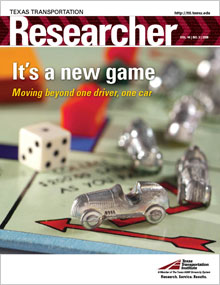Commuters give their two cents about carpooling

Over the years—with more affordable gas prices and roadways that seemed infinite in their capacity for handling traffic—drivers got in the habit of hopping in their cars and going places. But these days, with higher gas prices and more congested roadways, it’s getting increasingly expensive and time consuming—not to mention irritating—as we sit in bumper-to-bumper traffic.
As transportation agencies determine how to best serve the traveling public, more efficient use of our freeway lanes (rather than merely building more roads) is at the top of their to-do lists. Making trips for commuters both safer and timelier by offering alternatives to the one driver, one car scenario furthers that goal, and managed lanes are one way to meet it.
So, what are “managed lanes”? They’re roadways, like high-occupancy vehicle (HOV) lanes or toll roads, where different strategies are applied to achieve a high level of service. Properly planned, designed and operated, managed lanes can offer viable travel choices, shorten trip time for commuters and generate revenue for their operation.
With these issues in mind, the Texas Department of Transportation (TxDOT) and Texas Transportation Institute (TTI) are looking at how giving preferential treatment to carpools in priced managed lane facilities can impact the performance of these facilities.
“We surveyed commuters in Houston and Dallas to determine why people carpool and what might motivate them either positively or negatively about using managed lanes,” explains TTI Research Engineer Ginger Goodin. “We want to determine how drivers make choices to pay for a trip or use an alternative mode of travel.”
From the 4,600 or so responses they received, the TTI team discovered some interesting facts about drivers’ attitudes toward carpools and managed lanes. “We found that access to the HOV lanes, and the time savings associated with them, were very important in why drivers choose to carpool,” explains Goodin.
The research team examined specific carpool scenarios—for example, whether or not carpoolers should pay to use managed lanes—and made recommendations to TxDOT regarding how each scenario might play out. Alternative scenarios that allow for variations on free or paid use of the managed lanes by carpoolers were evaluated in terms of broad goals, such as the movement of people (as opposed to vehicles), performance of the lanes, revenue generation, emissions reduction, enforcement and operational simplicity, and public perception and support.
Not surprisingly, allowing toll-free carpools resulted in higher person throughput in the corridor, while conversely producing lower revenue. The researchers also concluded that developing a clear understanding of the goals for a managed lanes project is the first step in selecting the best carpool policy for that project, since different policies meet different needs. Armed with these findings, TxDOT can help areas tailor managed lanes solutions to local commuters’ needs.
“This research is showing us that we need true performance-based measures to guide the implementation of pricing policies,” explains Matt MacGregor, TxDOT’s tollway director in the Dallas District. “And more effective measures will result in a more efficient application of pricing.”
